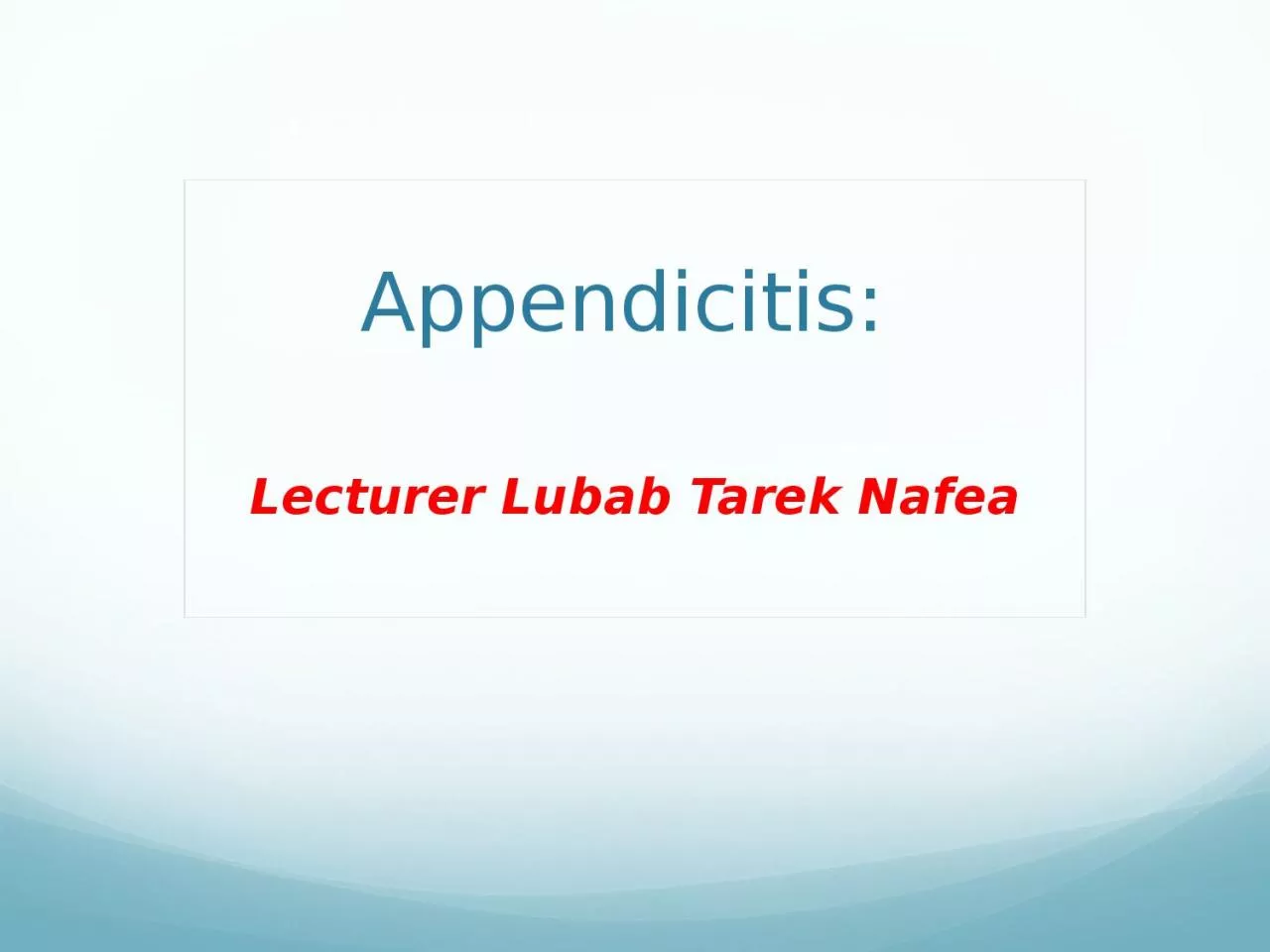

Lubab Tarek Nafea Appendicitis is defined as an inflammation of the inner lining of the vermiform appendix that spreads to its other parts Epidemiology Commonest cause of an acute abdomen and surgical admission in the UK ID: 1037341
Download Presentation The PPT/PDF document "Appendicitis: Lecturer" is the property of its rightful owner. Permission is granted to download and print the materials on this web site for personal, non-commercial use only, and to display it on your personal computer provided you do not modify the materials and that you retain all copyright notices contained in the materials. By downloading content from our website, you accept the terms of this agreement.
1. Appendicitis: Lecturer Lubab Tarek Nafea
2. Appendicitis is defined as an inflammation of the inner lining of the vermiform appendix that spreads to its other parts. EpidemiologyCommonest cause of an acute abdomen and surgical admission in the UK. Approximately one in seven people will have an appendicectomy. It most commonly occurs between 10 and 20 years; it is rare under 3 years of age.
3. Anatomy
4. Anatomical variantsLocalisation gives all the symptoms appendicitis – «monkey» of all the diseases
5. Classification – on the stage of destructive changesI. Acute appendicitisII. Chronic appendicitis – result of the not operated resolved acute appendicitis.
6. Etiology and pathogenesis1. Mechanical reason - obturation of the appendix lumen(coprolythiase, bending , foreign body)luminal hypertension vessels’ compression, interruption of the venous and lymphaticoutflow, oedema of the organ’s wall, vessels’ thrombosisloss of the barrier function of the mucouspenetration of the intestinal flora into the wall of the appendixmural destruction2. Vascular reason3. Infectious reason
7. Clinical features/Can vary a lot, considering anatomical variations of the appendix positionAbdominal painInitially vague, colicky central abdominal pain.Visceral pain caused by luminal obstruction of the appendix and stretch of the visceral peritoneum.Localising to the right iliac fossa and becoming constant.The pain changes as the parietal peritoneum becomes involved.Usually accompanied by a low-grade fever, nausea, vomiting and anorexia.The appendix position varies and can result in different symptoms; for example a pelvic appendix may cause urinary symptoms or diarrhoea.On examination there may be general signs of sepsis:Usually a low-grade pyrexia initially, which may spike up to 38–39°C in the presence of perforation or abscess formation.There may be tachycardia, flushing and evidence of dehydration.
8. Pain irradiations into :the perineum – if pelvic localisation right lumbar region – if retroperitoneal localisation right flank right hypochondrium – if retrocecal localisation in mesogastrium - if median localisation
9. Abdominal examinationTenderness over McBurney’s point is the usual feature.There may also be signs of peritoneal inflammation, including:Guarding, tenderness on percussion, pain on coughing or other movement.Signs of generalised peritonitis may develop as the illness progresses with abdominal rigidity.Rovsing’s sign: Pain is felt in the RIF when pressure is applied to the LIF.There must also be RIF tenderness for this sign to be positive.Psoas sign: The patient keeps his or her hip in flexion to relieve his or her pain.The appendix is anatomically adjacent to the psoas muscle, which is involved in hip flexion.PR examination may reveal tenderness anterolaterally on the right.
10.
11.
12.
13. Diagnosis The diagnosis of appendicitis is a clinical one; however there are some tests that may be useful, particularly where the diagnosis is not clear-cut. These include:The performance of a full blood count (FBC) can be useful to determine whether or not the patient has a leucocytosis.A urinalysis to exclude urinary tract infection. Although appendicitis may cause a hematuria or pyuria with associated urinary symptoms.A pregnancy test in women of child-bearing age is mandatory to rule out an ectopic pregnancy.An ultrasound scan (USS) in women to exclude tubo-ovarian pathology as the cause of RIF painA computed tomography (CT) scan can be useful especially in the elderly where a caecal tumour may be causative, or in the obese where examination is difficult.Diagnostic laparoscopy allows immediate treatment if appendicitis is confirmed.Urea and electrolytes (U&E) should also be performed to assess hydration status.
14. ALVARADO SCORING SYSTEM SYMPTOMS SCORE
15. ScoreInference 7-10Strongly predictive of appendicitis5-6EquivocalRadiological investigations1-4Appendicitis ruled out
16. Management Patients are often dehydrated at presentation and so require fluid resuscitation. IV fluids should be continued whilst the patient remains starved for theatre. Open appendicectomyUsually performed in children.A Lanz incision is used for the best cosmetic result.If the appendix is found to be perforated or gangrenous, then peritoneal lavage is performed to remove any pus or contamination.Most patients can be discharged on the second or third day post-operatively. Laparoscopic appendicectomyImproves diagnostic accuracy and minimises negative appendicectomy rates.It is indicated in patients who are unwell but there is question as to the diagnosis, and is particularly indicated in young women.It is useful in the obese where wound infections are more common and laparoscopic procedures have lower wound infection rates.There is now evidence to suggest that laparoscopic appendicectomy should be performed where expertise is available for this to be done.Laparoscopy has decreased length of stay in hospital, faster return to normal diet and activities and better post-operative pain.If the patient presents late (usually after several days of symptoms) with a palpable appendix mass, he or she requires CT scanning to determine whether there is an associated appendix abscess or a perforated caecal tumour.The initial management of an appendix abscess is conservative with IV fluids, antibiotics and observation. They may require radiological drainage.If there is deterioration, or frank perforation, surgery may still be required.
17. Indications of AppendectomyAcute Appendicitis Recurrent Appendicitis Mucocele of AppendixCarcinoma
18. Incisions in appendectomy
19. TreatmentAbsolute bed rest & NPO IV Fluids SupplementsAnalgesicsAntibioticsAppendectomy ( within 24 hours ASAP)
20. Complications Abscess formation; peri-appendicular, pelvic or sub-hepatic.Post-operative collection or abscess.Wound problems, including infection or haematoma.Intestinal obstruction due to adhesion formation within the abdomen.
21. Thank you